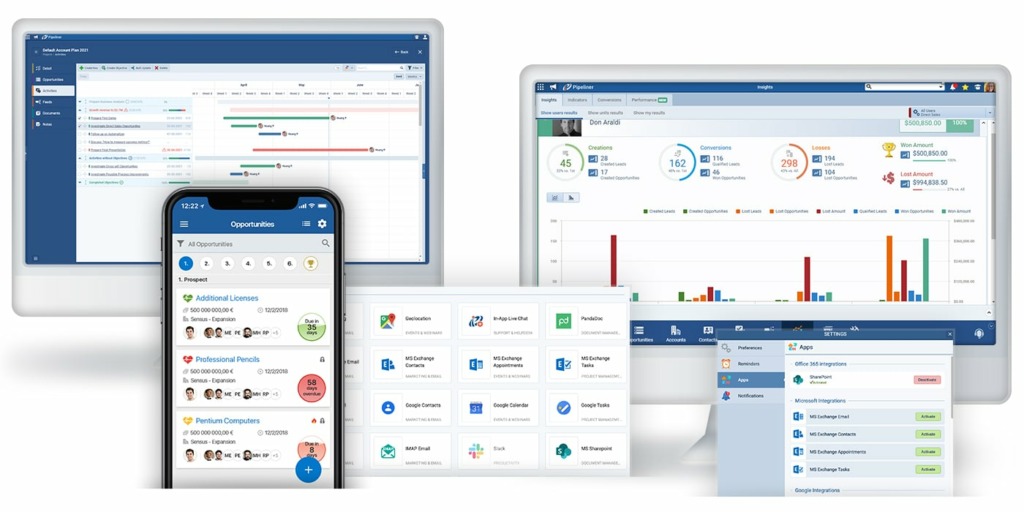When it comes to managing your sales process, two of the most popular tools on the market are Pipeliner CRM and HubSpot Sales Hub. Both are designed to help businesses streamline their sales process, but they differ in the features they offer and the approach they take to sales management. In this article, we’ll take a closer look at the features of each tool and how they compare.
Pipeliner CRM Features
Pipeliner CRM is a sales management tool designed to provide a complete view of the sales pipeline, from prospecting to closing. With Pipeliner CRM, sales teams can easily manage their leads and contacts, track the progress of opportunities through the sales cycle, and monitor their performance using custom KPIs and reports.
One of the standout features of Pipeliner CRM is its Sales Pipeline View. This unique feature provides a visual representation of the entire sales process, including the current status of each deal and the expected revenue from each deal. This makes it easy for salespeople to see where each deal is in the sales process and what actions they need to take to move it forward.
In addition, Pipeliner CRM offers a range of advanced sales analytics tools, including custom KPIs, sales forecasting, performance tracking, and powerful advanced reporting. These tools make it easier for sales teams to optimize their sales process for maximum efficiency and effectiveness, while at the same time identifying areas for improvement.
Pipeliner CRM also offers a range of integrations with other most often-used enterprise tools and platforms, including email marketing, social media platforms, and e-commerce platforms. This makes it easier for businesses to integrate Pipeliner CRM into their existing workflows.
Finally, Pipeliner CRM is designed to be easy to use, even for non-technical salespeople. Its completely visual interface is intuitive and user-friendly, and it is fully customizable to fit the unique needs of any business.

HubSpot Sales Hub Features
HubSpot Sales Hub is a sales management tool designed to help businesses manage their sales process more effectively. Like Pipeliner CRM, Sales Hub offers a range of features for lead and contact management, deal tracking, and sales reporting.
One of the standout features of Sales Hub is its ability to integrate with other HubSpot tools, including marketing automation and customer service tools. This makes it easier for businesses to manage all aspects of the customer journey in one place.
Sales Hub also offers a range of advanced sales analytics tools, including custom dashboards and performance tracking. This makes it easy for sales teams to see how they are performing and where they can make improvements.
In addition, Sales Hub offers a range of sales automation tools, including email sequencing, meeting scheduling, and document tracking. These tools can help sales teams save time and streamline their workflows.
Finally, Sales Hub is designed to be easy to use and customizable. The tool is fully integrated with the rest of the HubSpot platform, making it easy for businesses to manage all aspects of the customer journey in one place.
Comparing Features
While both Pipeliner CRM and HubSpot Sales Hub offer a range of sales process features, there are some key differences between the two tools.
Firstly, Pipeliner CRM’s Sales Pipeline View is a unique feature that provides a customizable visual representation of the entire sales process, making it easier for salespeople to see where each deal is in their sales process, and what actions they need to take to move it forward. Sales Hub, on the other hand, does not offer a similar feature.
Secondly, Pipeliner CRM offers a range of advanced sales analytics tools, including custom KPIs, sales forecasting, advanced reporting, and performance tracking. While Sales Hub also offers sales analytics tools, they are not as extensive as those offered by Pipeliner CRM.
Thirdly, both Pipeliner CRM and Sales Hub offer a range of sales automation tools, such as email sequencing, meeting scheduling, and document tracking. However, the specific features and functionality of these tools may differ between the two platforms.
In conclusion, both Pipeliner CRM and HubSpot Sales Hub offer a range of features designed to help businesses streamline their sales process and improve their sales performance. Each platform has its own strengths and weaknesses, and the best choice for your business will depend on your specific needs and priorities.
Pipeliner CRM’s Sales Pipeline View and advanced sales analytics tools make it a great choice for businesses looking for a visual representation of their sales process and in-depth insights into their sales performance. Its user-friendly interface and customizability make it a good option for businesses of all sizes and technical abilities.
On the other hand, HubSpot Sales Hub’s integration with other HubSpot tools, sales automation features, and extensive reporting capabilities make it a powerful platform for businesses looking to manage all aspects of the customer journey in one place. Its user-friendly interface and scalability make it a good option for growing businesses.
Overall, both Pipeliner CRM and HubSpot Sales Hub are excellent choices for businesses looking to improve their sales performance and streamline their sales process. It’s important to carefully evaluate the features of each platform and consider your specific business needs before making a decision.





















Comments